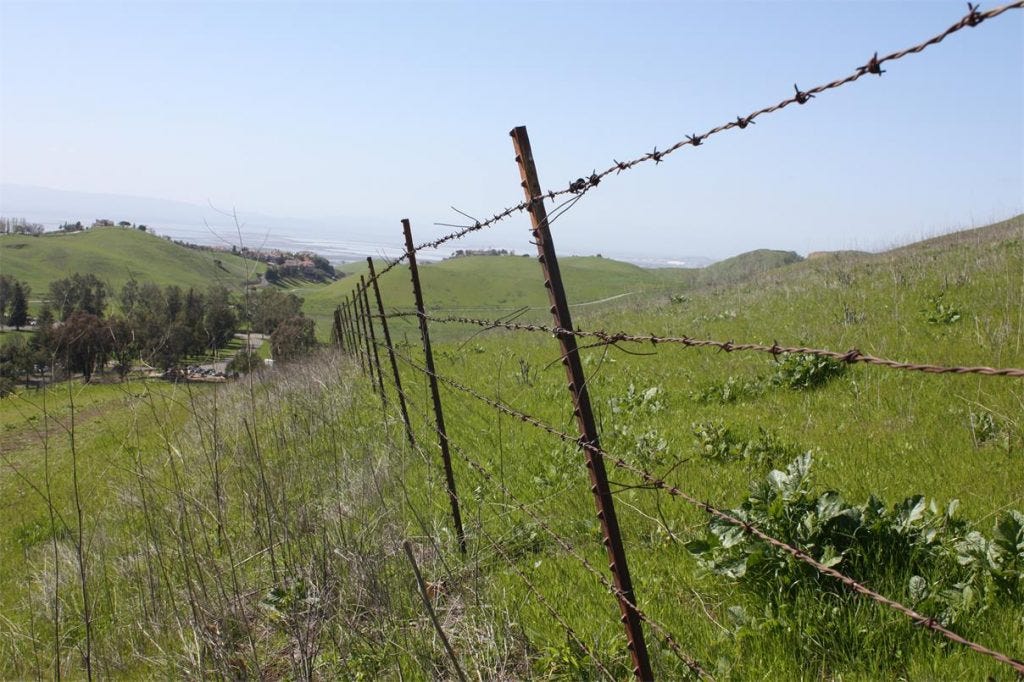The other side of the fence
We've put up a lot of fences, and sometimes they get in the way of critters (4 minute read)
This week, I feature a guest post by American environmentalist and writer Paul Hormick. He talks about the impact of fences on wildlife in the USA, in contrast to my article about the benefits of predator-proof fences on New Zealand’s native species.
When we think of things that we build that get in the way of wildlife, it can be easy to concentrate on the big things, the dams that stop fish from swimming in a stream or the freeways that inhibit large animals from moving through their natural habitat. It may be easy to overlook the effect that fences have on wildlife. After all, they appear far less imposing. I remember watching deer jump over the barbed wire fences we had that kept our cows on our farm and thinking that nature was doing just fine, as far as our fences were concerned.
But fences are among the oldest and most pervasive barriers we’ve put up. All the fencing in the world might exceed the total length of roads by an order of magnitude, and it continues to grow.
Rabbits and snakes may have no behavioral changes once a barbed wire fence goes up, but larger mammals sometimes do. If they don’t immediately jump over the fence or otherwise find a way under it or through it, they will do what you might expect people to do in the same situation. Some larger animals “patrol” the fence, looking for openings, while others deflect away. They might go back and forth along a short segment of the fence, or even get trapped for a time when they wander into a more enclosed area of fencing.
Seemingly harmless enough, fences can restrict wildlife from normal migration (photo credit: razorfencewire.com)
A team of scientists recently examined the effects fencing has on two large North American mammals, the pronghorn and mule deer, who both can range over large areas. The researchers chose just over 17,350 square kilometers of variable habitat that ranges from sagebrush (a type of shrub) to aspen forest in western portion of Wyoming, a mountainous and sparsely populated state of the U.S. The habitat is used by both pronghorn and mule deer for seasonal migration. Most of the fencing is four or five-strand barbed wire, used for livestock and right of ways along roads, and in the southern part of the study area.
Pronghorns occupy deserts, grasslands and shrub environments such as coastal sage scrub, and chaparral, from Canada, through the Western United States, and south into Mexico. They feed mostly on sagebrush, herbs, and grasses. The males have curving, black antlers that give the appearance of a headdress. They stand about 84 to 104 cm and are about 1.3 to 1.5 meters in length. Pronghorns may range up to 160 kilometers from winter ranges to avoid deep snow. Biologists estimate that before white people came to North America, there were about 35 million pronghorns. Their numbers now are in the tens of thousands. Despite their much lower numbers, they are not considered vulnerable to extinction and are a game species. Pronghorns may move up to 160 km from winter ranges to avoid very deep snow.
Mule Deer range over more varied landscapes, from forests, to chaparral, to grasslands throughout North America, and eat mostly succulents. The males (or bucks, as many folks say) grow large, multipronged antlers. Standing 80 to 106 cm and measuring 1.2 to 2.1 meters in length, they tend to confine themselves to home ranges, migrating from higher elevations to lower with the onset of winter. Mule deer are not considered of critical conservation status.
The scientists found that for both pronghorns and deer, almost 40 percent of their fence encounters altered their normal movement. Most often, both species “bounced” from the fencing, meaning that they retreated from the fence. Otherwise, the pronghorns and deer would scout back and forth along the fence, or patrol, looking for an opening. On a few occasions the animals behaved as if they were trapped.
Just put yourself into the hooves of these animals. The bouncing and looking for an opening, are like getting stuck in traffic or hitting some kind of roadblock, which is a big waste of time. Delays like this can go on for a long time. Gazelles in Mongolia have traced fences for as long as 59 days before finding a crossing. Animals also injure themselves as the try to cross fences. Mule deer can get their legs tangled in barbed wire and die. Pronghorns can get their antlers stuck as they try to make their way under a fence.
Such restrictions on the movement of large animals have been found by other recent research to cause population declines in species. There has been a push to transition to semipermeable fencing, which is intended to rein in cattle but allow passage for other large animals such as elk, but even these more ecologically friendly constructions have been found to restrict large animal movement and compromise their ability to find food or breeding sites.
Because they can be problematic, some folks have started removing fences altogether from our landscapes. As this problem has just recently received attention from policy makers and scientists, the movement is still small. Still, there are such organizations as the Absaroka Fence Initiative that works with landowners to convert to more environmentally friendly fencing or remove fencing altogether.
If you enjoyed this article, why not subscribe to Paul Hormick’s newsletter, The Green Dispatch, for more environmental articles. And let us know what you thought in the comment box below.








